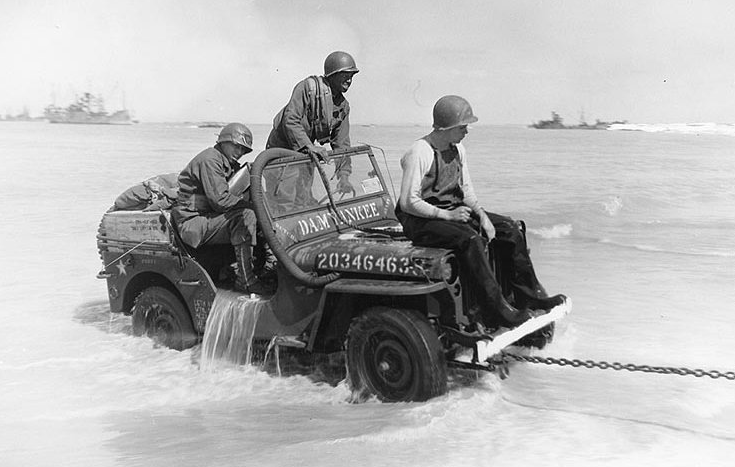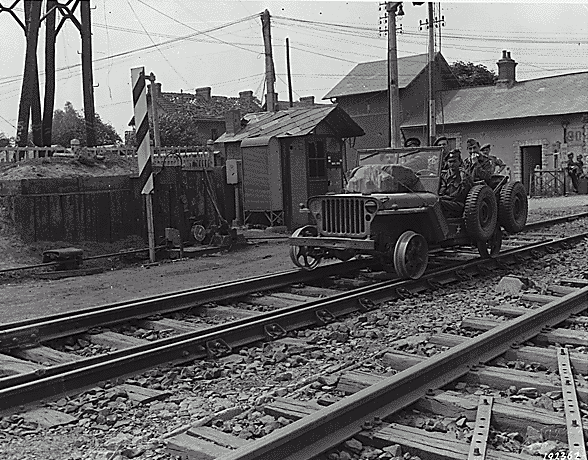
A U.S. Army Jeep 4x4 is towed ashore on a Normandy beach, 12 June 1944



A U.S. Army Jeep 4x4 is towed ashore on a Normandy beach, 12 June 1944
In 20th century warfare, one of the biggest keys to victory was mobility. At the end of WWI, Germany revolutionized the war front with mechanized warfare. The American and British military also recognized the need to replace the horse with dependable mechanized transportation. As early as 1906 the Four Wheel Drive Auto Company of Clintonville, Wisconsin, developed the FWD vehicle. In 1914, two FWD trucks were sent to England for evaluation by the military, followed by an order for 50 trucks. By the end of 1917 almost 400 FWD trucks were being used by the British military in the European war, and almost 18,000 were put into use before WWI ended in November, 1918. This proved the concept of a military four wheel drive vehicle. Various types of four wheel drive vehicles were developed by the automobile industry, including the Jeffery Quadruple Drive Truck, also known as the "Quad." After Nash bought the company it became known as the Nash Quad and it saw some use during WWI. Following WWI, there was a need to develop a smaller, more nimble vehicle. The military even tested a stripped down Model T Ford. Other vehicles like the Dodge Command Car, the Dodge Weapons Carrier, and the Marmon-Herrington conversion done to Ford V8 half ton trucks appeared. Major Robert Howie even created a small vehicle designed to carry two people laying down.
Frank Fenn, the factory manager (reported as the company president in some sources), realized the opportunity in developing a small military vehicle on the verge of WWII. While on the verge of bankruptcy, American Bantam invited members of the US military to test some rear wheel drive vehicles they developed. This in turn created enough interest from the military to create the specifications for the first jeep (lower case) vehicle. In 1940 the US Army sent requests for bids out for four-wheel drive vehicles, with a small wheelbase, and a weight limit of 1300 pounds and payload of 600 pounds. And the Army wanted prototype vehicles in only 49 days, a seemingly impossible deadline. American Bantam recruited Karl Probst, an engineer, who worked on a contingency basis since American Bantam was strapped financially. After a frantic 33 hours, Probst had the basis of a design for what would become the legendary Jeep.
American Bantam created an acceptable design, far ahead of the auto industry giants, and forged the basis of the design of the jeep. The Army, insisting that the blueprints from American Bantam were their property, gave them to Bantam's competitors in order to have a more diversified manufacturing base. Ultimately it came down to prototypes from Bantam, Ford Motor Company and Willys-Overland. The Army believed Ford Motor Company had the manufacturing strength and stability to be able to provide enough vehicles. Ford and Willys-Overland delivered concept vehicles based on the Bantam design: the Ford Pygmy and the Willys-Overland Quad. Clearly, Ford and Willys had better overall mechanical designs than Bantam, however, Bantam had the best fuel economy and braking. The Army increased the maximum weight from 1300 pounds to 2160. Ford and Bantam met that requirement but Willys was the heaviest at 2450 pounds.
The Army wanted a vehicle that combined the best of all three vehicles. Willys-Overland gave the Army the lowest bid. The original Willys prototype was renamed the MA and the Army created a new set of specifications which became known as the MB. This set of specifications were for the first jeep vehicle and the first contract was awarded to Willys-Overland. Later, in 1941, the Army realized the jeep had exceeded their expectations and wanted a second source. They turned back to Ford who won a contract to manufacture an additional 15,000 General Purpose Willys, or GPW, vehicles, based on the standardized MB design. Despite complaints by American Bantam's Fenn, Willys-Overland was contracted to manufacture 362,841 jeep vehicles, and Ford produced 281,448. Bantam produced only 2,643 under contract.

Jeeps were used by every branch of the U.S. military. An average of 145 were supplied to every Army infantry regiment. Jeeps were used for many other purposes including cable laying, saw milling, as firefighting pumpers, field ambulances, tractors and, with suitable wheels, would even run on railway tracks going into Germany. Strapping a .50 caliber (M2) machine gun to a jeep vehicle made it an effective weapon of war. General Eisenhower credited the jeep to being one of the factors in winning WWII. The jeep's 4 wheel drive design allowed it go anywhere it was needed. The simplistic design was effective and popular later on in a postwar market. Near the end of WWII, Ford's contract with the military ran out but it was already clear that this vehicle would have a life beyond WWII. Even before the end of WWII, the sole producer of the jeep, Willys-Overland, announced the civilian version of the jeep, the CJ-2A which was produced until 1949.
In 1945, after the end of WWII, Willys-Overland applied for a trademark, officially turning "jeep" into "Jeep®". After multiple wars and over 30 years of service the Jeep was retired from the United States military. The legendary Jeep paved the way for Sport Utility Vehicles and a way of life for others. If you're lucky enough to have one of these classics, check out our Willys Jeep parts for your restoration projects.